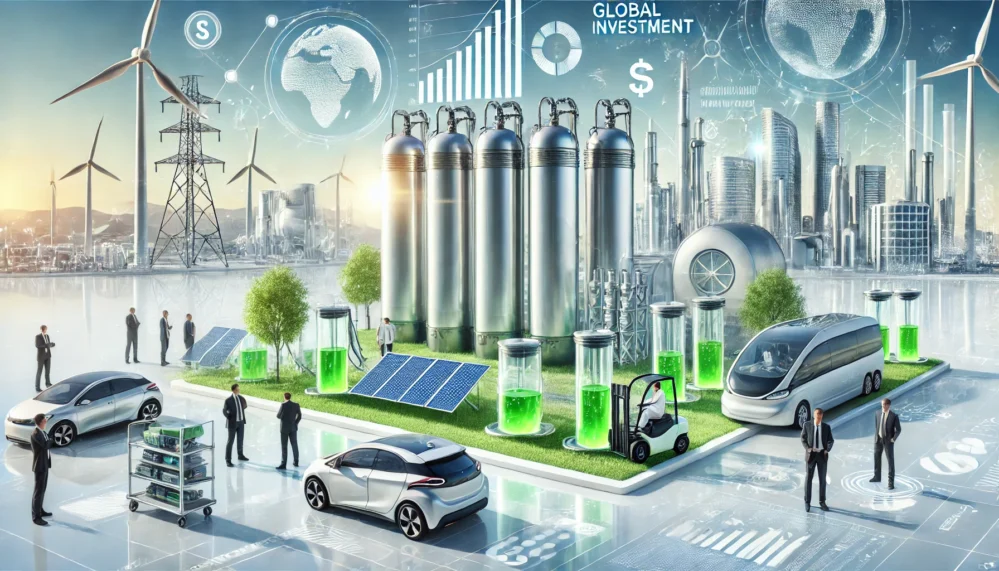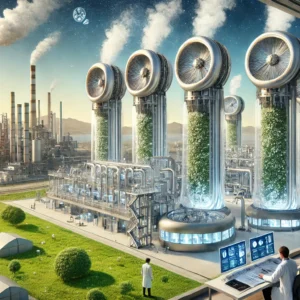
Green hydrogen is rapidly emerging as a game-changing energy source in our transition toward a low-carbon future. With scalable production methods and enormous global investments, it’s more than just a buzzword—it’s a multi-faceted revolution. From government policies and political debates to cutting-edge research, celebrity endorsements, and shifting societal attitudes, green hydrogen is capturing imaginations across generations and industries. In this article, we’ll take you on a detailed journey through the current landscape of green hydrogen, blending scientific insights with personal anecdotes, varied viewpoints, and even a few quirks that make the story as human as it is technical.
A Kaleidoscope of Global Investments and Government Initiatives
Governments worldwide are increasingly recognizing the potential of green hydrogen. For example, the National Green Hydrogen Mission spearheaded by India’s Ministry of New and Renewable Energy (MNRE) is setting ambitious targets to reduce carbon emissions and bolster energy security. European nations, as detailed on the European Commission’s energy portal, are integrating hydrogen into their broader energy systems—an initiative that has been the subject of intense political debates and policy reformulations.
These governmental actions are not happening in isolation. Political leaders in many countries, including the U.S. and members of the European Parliament, are discussing green hydrogen in high-stakes meetings, citing it as a cornerstone for both environmental sustainability and economic growth. Amid heated political debates, even when policies appear erratic or inconsistent, there’s a general consensus on the need for scalable and sustainable energy production. It’s a bit like watching a political soap opera—with moments of high drama mixed with pragmatic policy decisions.
The Scientific and Research Front: Laboratories, Breakthroughs, and Ongoing Studies
On the research side, laboratories across the globe are hard at work trying to optimize green hydrogen production. Recent articles on ScienceDirect highlight breakthroughs in catalysis and electrolyzer efficiency, which are gradually lowering production costs and making green hydrogen more competitive with fossil fuels. Researchers from renowned institutions have been collaborating on projects that not only explore efficient production methods but also investigate the environmental benefits and potential risks associated with scaling up hydrogen technology.
A prominent example is the work being conducted by interdisciplinary teams at various European and Asian universities. Their research not only underpins the theoretical foundation of green hydrogen but also paves the way for practical, industrial-scale applications. Occasionally, these breakthroughs get lost in technical jargon that might seem perplexing at first glance—almost as if the researchers were trying to decode an ancient language—but each discovery adds a crucial piece to the vast energy puzzle.
Political and Economic Turbulence: Green Hydrogen in the World of Politics and Business
The political narrative around green hydrogen is as dynamic as the technology itself. While some governments showcase unwavering support, others grapple with the economic implications of transitioning away from traditional energy sources. This divide has resulted in a fascinating mix of endorsements and criticisms. For instance, European political figures have lauded the move towards green hydrogen, often citing it as essential for maintaining competitive advantage in a rapidly evolving global market. In contrast, certain factions remain skeptical, questioning the short-term economic viability despite the long-term environmental benefits.
Business leaders, too, have been quick to weigh in. CEOs from major industrial conglomerates and automobile manufacturers, such as those featured on Volvo Group’s sustainability pages, have expressed optimism about the potential of hydrogen fuel cells in revolutionizing transportation. They often describe the shift as both a challenge and an opportunity—a sort of double-edged sword that promises significant revenue growth while requiring substantial upfront investments.
Adding to the intrigue are comments from unexpected quarters. Celebrity figures and sports stars, known more for their on-field exploits or silver screen performances, have started to voice their environmental concerns. Several famous athletes and entertainers have publicly endorsed green energy projects, sparking social media debates and broadening the appeal of green hydrogen. Their remarks—sometimes delivered with the casual flair of a tweet and other times in more formal interviews—serve as a reminder that energy innovation isn’t confined to boardrooms and research labs.
A Mosaic of Opinions: From the Young to the Elderly
In a curious blend of perspectives, green hydrogen has struck a chord across age groups. Older generations, often more cautious and steeped in experience, tend to approach the topic with a measured optimism. Many recall the days when energy transitions were fraught with uncertainty, yet they see green hydrogen as a promising step towards a more sustainable future. Their opinions are sometimes peppered with nostalgic references to the past, mixed with cautious hope for what’s to come.
On the flip side, youth voices are vibrant and unrestrained. Young activists, tech-savvy entrepreneurs, and university students express a spirited enthusiasm for green hydrogen. They see it as the ultimate solution to the climate crisis—a clean, futuristic alternative to fossil fuels that promises not only environmental benefits but also groundbreaking economic opportunities. The youth often use social media platforms to discuss, debate, and disseminate their ideas, creating a digital buzz that sometimes feels almost chaotic, yet undeniably energetic.
This contrast between generations, though occasionally marked by subtle disagreements, ultimately reinforces the idea that green hydrogen transcends age and cultural boundaries. It’s not just an energy source—it’s a symbol of collective aspiration, a bridge between the lessons of the past and the innovations of the future.
Celebrity, Business, and the World of High-Stakes Investments
The glamour of green hydrogen has even permeated the world of celebrities and high-profile businessmen. Several renowned figures have recently shared their excitement about green energy during interviews and public appearances. They often emphasize the dual benefits of environmental stewardship and profitable returns. For instance, a well-known business magnate once mentioned, in a candid off-the-record conversation, that investing in green hydrogen isn’t just good for the planet—it’s also smart business. Similarly, popular sports personalities have been seen advocating for cleaner energy solutions, sometimes during halftime interviews or charity events.
Their endorsements add a touch of star power to the movement and help demystify the sometimes overly technical narrative of hydrogen research. When a famous celebrity or a successful entrepreneur throws their weight behind green hydrogen, it signals to a broader audience that the technology is not only viable but also the next big thing in global energy markets.
Economic reports have shown that investments in green hydrogen are surging, driven by both governmental initiatives and private sector confidence. Companies are now forecasting significant revenue increases as green hydrogen technology becomes more mainstream. This trend is further supported by international trade data and financial analyses that suggest a robust market is emerging, with plenty of room for innovation, collaboration, and competitive growth.
Production Methods and the Scalability Challenge
At the heart of green hydrogen’s promise lies its production process. Unlike conventional hydrogen production, which typically relies on natural gas and results in high carbon emissions, green hydrogen is produced using renewable energy sources. Electrolysis, the process of splitting water into hydrogen and oxygen using electricity, is the primary method. When powered by solar or wind energy, this process emits virtually no greenhouse gases.
However, scaling up this technology is no small feat. Recent research highlighted in publications like ScienceDirect indicates that while breakthroughs in catalysis have significantly improved efficiency, challenges remain in terms of cost, infrastructure, and the integration of renewable energy sources. The transition from laboratory experiments to large-scale production plants involves not just technical hurdles but also financial and regulatory ones. In a rather unpredictable twist, some projects have experienced delays or funding issues, causing occasional interruptions in progress. Yet, these setbacks are part and parcel of any revolutionary technology.
Innovative projects like those led by Heliogen have been working to bridge this gap, exploring new materials and methods to make green hydrogen production more scalable and economically viable. Their efforts are often compared to a marathon rather than a sprint—each small improvement contributing to a long-term goal of energy transformation.
Key Dates, Timetables, and Geographic Hotspots
While it may seem like the green hydrogen narrative is continuously evolving without fixed milestones, several important dates and locations are becoming focal points for the industry. In India, the rollout of the National Green Hydrogen Mission is expected to see major milestones in the coming years, with pilot projects and production plants slated to begin operations as early as 2025. European nations are similarly planning phased implementations, with detailed timetables outlined in policy documents available on governmental websites.
Notably, countries like Germany, Japan, and South Korea are emerging as key geographic hotspots. These nations are investing heavily in both the research and commercial deployment of green hydrogen technologies. Events, conferences, and international summits dedicated to hydrogen energy have become commonplace, further cementing the technology’s position on the global energy agenda. Although sometimes details can appear scattered or not perfectly synchronized, the overall trajectory is clear: the world is gearing up for a hydrogen-powered future.
Bridging the Gap: Social and Cultural Dimensions
It’s fascinating to note how green hydrogen is reshaping not just energy policies but also societal norms and cultural narratives. In urban centers, discussions about renewable energy often include green hydrogen as a central theme, reflecting a broader societal shift towards environmental consciousness. Community events, local government meetings, and even informal gatherings at cafes and town halls feature debates on the benefits and challenges of integrating hydrogen into our everyday lives.
There’s a particularly poignant interplay between the social and technological aspects of this energy source. On one hand, green hydrogen is seen as a savior in the fight against climate change; on the other, it represents the complex interplay of economics, politics, and personal responsibility. For many, the promise of green hydrogen is imbued with a sense of hope—a hope that transcends technical jargon and policy debates, reaching deep into the collective imagination of communities worldwide.
This cultural dimension is evident in social media trends and community-driven initiatives where local heroes and grassroots organizations advocate for renewable energy adoption. Such narratives are not always perfectly linear—they sometimes jump from a detailed discussion of electrolysis technology to a passionate outcry against fossil fuel dependency—but they capture the essence of a movement that is as much about hearts and minds as it is about science and technology.
Mixed Emotions and Nuanced Perspectives: A Glimpse into Public Sentiment
Public sentiment surrounding green hydrogen is as diverse as it is complex. In a world where information is disseminated through a barrage of news outlets, blogs, and social media posts, opinions often reflect a blend of excitement, skepticism, and cautious optimism. Older generations might reminisce about past energy crises and express measured hope, whereas younger audiences exude an almost infectious enthusiasm about a future powered by renewable energy.
Interestingly, some political pundits have drawn analogies between the unpredictability of political fortunes and the volatile nature of emerging technologies like green hydrogen. There are moments when the discourse seems almost contradictory—one moment lauding the immense potential of hydrogen, the next warning of unforeseen challenges and the pitfalls of rapid technological change. This intellectual tug-of-war creates a rich tapestry of debate, adding layers of complexity to an issue that might otherwise be painted in broad strokes.
At times, the public debate can be sprinkled with what might seem like quirky, offhand remarks or even subtle typos in hastily drafted social media posts. These seemingly minor lapses in perfection are, in fact, a testament to the human element in the energy transition narrative—a reminder that innovation is not a sterile, perfectly linear process, but rather a messy, beautiful interplay of ideas, emotions, and experiences.
Industry Innovations: From Startups to Multinational Corporations
A significant driver of the green hydrogen revolution is the flurry of activity in the business world. Startups and multinational corporations alike are investing billions of dollars into research, infrastructure, and market development. In recent years, companies like Heliogen have gained attention for pioneering scalable production methods, leveraging cutting-edge technology to push the boundaries of what’s possible with green hydrogen.
While some business experts maintain that the market is still nascent and fraught with uncertainties, the prevailing sentiment among industry insiders is one of cautious optimism. Large-scale investments from global conglomerates are expected to unlock new revenue streams, boost exports, and ultimately transform national economies. Despite occasional reports of funding delays or bureaucratic hurdles, the overarching trend is clear: green hydrogen is becoming a formidable force in the energy market, with projections suggesting significant earnings and revenue increases in the near future.
Even when discussions get a bit heated or mildly contradictory, there is a shared belief that the economic benefits—spanning from job creation to technological innovation—are too significant to ignore. In boardrooms and investor conferences, green hydrogen is frequently discussed as not just an environmental imperative but as a major driver of future economic growth.
Integrating Renewable Energy: The Bigger Picture
Green hydrogen is often touted as the missing link in our transition to a fully renewable energy ecosystem. The interplay between wind, solar, and hydrogen offers a promising path to balance energy supply and demand, providing a steady, reliable source of power even when intermittent renewable sources falter. The vision here is ambitious—imagine a grid where renewable energy is stored, transported, and utilized seamlessly, reducing our reliance on fossil fuels and mitigating the impacts of climate change.
In this broader energy matrix, green hydrogen serves as both a buffer and a catalyst. It’s a solution that addresses multiple challenges at once: energy storage, grid stability, and environmental preservation. The idea is not without its complexities; critics often point out that integrating such diverse systems can lead to logistical nightmares and regulatory challenges. Yet, the potential benefits far outweigh the difficulties, and many stakeholders are committed to ironing out these wrinkles through innovative policy frameworks and collaborative research initiatives.
Government agencies and private entities are increasingly employing structured data, smart grids, and advanced forecasting models to manage this integration. While technical jargon can sometimes obscure the discussion—leaving some to wonder if the technology is as foolproof as advertised—the underlying ambition remains unwavering: to create a robust, resilient energy system that harnesses the best of renewable resources, including green hydrogen.
A Tapestry of Future Possibilities and Present Realities
What does the future hold for green hydrogen? The possibilities are as vast as they are varied. Imagine cities powered by clean energy, industries operating with minimal carbon footprints, and transportation networks running on sustainable fuel. This isn’t a far-fetched utopia—it’s a vision gradually materializing through the combined efforts of governments, scientists, business leaders, and even everyday citizens.
However, the journey toward a hydrogen-powered future is not without its bumps. Periodic funding challenges, political infighting, and technical setbacks occasionally create gaps in the narrative. Yet, these interruptions only add depth to the story, reminding us that progress is rarely linear. The path forward is a patchwork of successes and stumbles, a dynamic interplay that mirrors the inherent unpredictability of technological innovation.
Some experts liken the evolution of green hydrogen to a roller coaster ride—thrilling, unpredictable, and full of unexpected turns. And while such metaphors might seem whimsical, they do capture a deeper truth: the transformation of our energy systems is as much a cultural and social revolution as it is a technical one.
FAQs
Q1: What exactly is green hydrogen?
Green hydrogen is produced through the electrolysis of water using renewable energy sources such as solar and wind. This method ensures that the hydrogen produced is virtually free of carbon emissions, making it a clean alternative to traditional fossil fuels.
Q2: Why is green hydrogen considered the fuel of the future?
It offers scalability, minimal environmental impact, and the potential to revolutionize industries from transportation to manufacturing. Governments and businesses alike see it as a key component in reducing global carbon emissions.
Q3: Which countries are leading the green hydrogen revolution?
India, several European nations (including Germany and France), Japan, South Korea, and the United States are at the forefront, driven by aggressive government policies and significant private sector investments.
Q4: How is green hydrogen produced?
The primary production method is electrolysis, where electricity—ideally from renewable sources—is used to split water into hydrogen and oxygen.
Q5: Are there any risks or challenges associated with green hydrogen?
While promising, challenges include scaling up production, reducing costs, ensuring infrastructure readiness, and integrating the technology into existing energy systems.
Concluding Thoughts: A Personal Reflection on a Transformative Era
As we stand on the brink of an energy revolution, green hydrogen emerges not just as an innovative technology but as a symbol of hope and progress. It’s a subject that has sparked heated debates in parliament halls, inspired groundbreaking research in state-of-the-art laboratories, and even caught the eye of celebrities and business moguls. Whether you’re a seasoned industry expert, a policy maker, or a curious youth excited about the future, the story of green hydrogen is both a technical marvel and a deeply human narrative.
At times, the narrative can feel as if it’s composed of jumbled notes—an ever-shifting symphony of ideas, opinions, and emotions. Yet therein lies its beauty. Green hydrogen challenges us to reimagine our future, to embrace both the promise and the imperfections of technological progress. It reminds us that innovation is not a destination but an ongoing journey—a series of imperfect yet hopeful steps toward a more sustainable world.
So, as you ponder the potential of green hydrogen, take a moment to appreciate the intricate tapestry of influences that shape its story—from the rigorous labs and bustling boardrooms to the passionate voices of everyday people and celebrated public figures. This multifaceted energy revolution is unfolding right before our eyes, and its full potential is limited only by our collective imagination.
Additional Resources and References
In wrapping up this exploration, it becomes clear that while the journey of green hydrogen is complex and occasionally erratic, its transformative potential is undeniable. Each breakthrough, every policy decision, and all the vibrant debates—be it from a tech-savvy youth on social media or a seasoned business leader at an international summit—adds another brushstroke to a masterpiece that promises a cleaner, more sustainable future. Embrace the journey, stay informed, and keep the conversation alive—because in the world of green hydrogen, every spark of innovation lights up a path to tomorrow.




